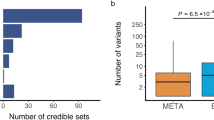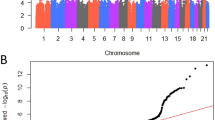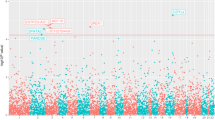Abstract
Circadian genes influence a variety of biological processes that are important in prostate tumorigenesis including metabolism. To determine if variants in circadian genes alter prostate cancer risk, we genotyped five variants in five circadian genes in a population-based case–control study conducted in China (187 cases and 242 controls). These variants included CRY2 rs1401417:G>C, CSNK1E rs1005473:A>C, NPAS2 rs2305160:G>A, PER1 rs2585405:G>C and PER3 54-bp repeat length variant. Men with the cryptochrome 2 (CRY2)-variant C allele had a significant 1.7-fold increased prostate cancer risk (95% confidence interval (CI), 1.1–2.7) relative to those with the GG genotype. This risk increased to 4.1-fold (95% CI, 2.2–8.0) in men who also had greater insulin resistance (IR) as compared to men with the GG genotype and less IR. In contrast, among men with less IR, the NPAS2-variant A allele was associated with decreased prostate cancer risk (odds ratio=0.5, 95% CI, 0.3–1.0) as compared to the GG genotype. Our findings, although in need of confirmation, suggest that variations in circadian genes may alter prostate cancer risk and some biological processes may modify this effect.
This is a preview of subscription content, access via your institution
Access options
Subscribe to this journal
Receive 4 print issues and online access
$259.00 per year
only $64.75 per issue
Buy this article
- Purchase on Springer Link
- Instant access to full article PDF
Prices may be subject to local taxes which are calculated during checkout
Similar content being viewed by others
Accession codes
References
Rutter J, Reick M, Wu LC, McKnight SL . Regulation of clock and NPAS2 DNA binding by the Redox state of NAD cofactors. Science 2001; 293: 510–514.
Rudic RD, McNamara P, Curtis AM, Boston RC, Panda S, Hogenesch JB et al. BMAL1 and CLOCK, two essential components of the circadian clock, are involved in glucose homeostasis. PLoS Biol 2004; 2: e377.
Turek FW, Joshu C, Kohsaka A, Lin E, Ivanova G, McDearmon E et al. Obesity and metabolic syndrome in circadian clock mutant mice. Science 2005; 308: 1043–1045.
Zvonic S, Floyd ZE, Mynatt RL, Gimble JM . Circadian rhythms and the regulation of metabolic tissue function and energy homeostasis. Obesity 2007; 15: 539–543.
Lejeune-Lenain C, Van Cauter E, Desir D, Beyloos M, Franckson JR . Control of circadian and episodic variations of adrenal androgens secretion in man. J Endocrinol Invest 1987; 10: 267–276.
Kubo T, Ozasa K, Mikami K, Wakai K, Fujino Y, Watanabe Y et al. Prospective cohort study of the risk of prostate cancer among rotating-shift workers: findings from the Japan collaborative cohort study. Am J Epidemiol 2006; 164: 549–555.
Conlon M, Lightfoot N, Kreiger N . Rotating shift work and risk of prostate cancer. Epidemiology 2007; 18: 182–183.
Band PR, Le ND, Fang R, Deschamps M, Coldman AJ, Gallagher RP et al. Cohort study of air Canada pilots: mortality, cancer incidence, and leukemia risk. Am J Epidemiol 1996; 143: 137–143.
Irvine D, Davies DM . British airways flightdeck mortality study, 1950–1992. Aviat Space Environ Med 1999; 70: 548–555.
Pukkala E, Aspholm R, Auvinen A, Eliasch H, Gundestrup M, Haldorsen T et al. Cancer incidence among 10,211 airline pilots: a Nordic study. Aviat Space Environ Med 2003; 74: 699–706.
Fu L, Lee CC . The circadian clock: pacemaker and tumour suppressor. Nat Rev Cancer 2003; 3: 350–361.
Zhu Y, Brown HN, Zhang Y, Stevens RG, Zheng T . Period3 structural variation: a circadian biomarker associated with breast cancer in young women. Cancer Epidemiol Biomarkers Prev 2005; 14: 268–270.
Zhu Y, Stevens R, Leaderer D, Hoffman A, Holford T, Zhang Y et al. Non-synonymous polymorphisms in the circadian gene NPAS2 and breast cancer risk. Breast Cancer Res Treat (e-pub ahead of print).
Zhu Y, Leaderer D, Guss C, Brown HN, Zhang Y, Boyle P et al. Ala394Thr polymorphism in the clock gene NPAS2: a circadian modifier for the risk of non-Hodgkin's lymphoma. Int J Cancer 2007; 120: 432–435.
Zhu Y, Zheng T, Stevens RG, Zhang Y, Boyle P . Does ‘clock’ matter in prostate cancer? Cancer Epidemiol Biomarkers Prev 2006; 15: 3–5.
Hsing AW, Deng J, Sesterhenn IA, Mostofi FK, Stanczyk FZ, Benichou J et al. Body size and prostate cancer: a population-based case–control study in China. Cancer Epidemiol Biomarkers Prev 2000; 9: 1335–1341.
Hsing AW, Chua Jr S, Gao Y-T, Gentzschein E, Chang L, Deng J et al. Prostate cancer risk and serum levels of insulin and leptin: a population-based study. J Natl Cancer Inst 2001; 93: 783–789.
Hsing AW, Gao YT, Chua Jr S, Deng J, Stanczyk FZ . Insulin resistance and prostate cancer risk. J Natl Cancer Inst 2003; 95: 67–71.
Hsing AW, Chokkalingam AP . Prostate cancer epidemiology. Front Biosci 2006; 11: 1388–1413.
Hsing AW, Gao YT, Wu G, Wang X, Deng J, Chen YL et al. Polymorphic CAG and GGN repeat lengths in the androgen receptor gene and prostate cancer risk: a population-based case–control study in China. Cancer Res 2000; 60: 5111–5116.
Hsing AW, Chen C, Chokkalingam AP, Gao Y-T, Dightman DA, Nguyen HT et al. Polymorphic markers in the SRD5A2 gene and prostate cancer risk: a population-based case–control study. Cancer Epidemiol BiomarkersPrev 2001; 10: 1077–1082.
Ebisawa T, Uchiyama M, Kajimura N, Mishima K, Kamei Y, Katoh M et al. Association of structural polymorphisms in the human period3 gene with delayed sleep phase syndrome. EMBO Rep 2001; 2: 342–346.
Archer SN, Robilliard DL, Skene DJ, Smits M, Williams A, Arendt J et al. A length polymorphism in the circadian clock gene Per3 is linked to delayed sleep phase syndrome and extreme diurnal preference. Sleep 2003; 26: 413–415.
Fu L, Pelicano H, Liu J, Huang P, Lee CC . The circadian gene period2 plays an important role in tumor suppression and DNA damage response in vivo. Cell 2002; 111: 41–50.
Amundadottir LT, Sulem P, Gudmundsson J, Helgason A, Baker A, Agnarsson BA et al. A common variant associated with prostate cancer in European and African populations. Nat Genet 2006; 38: 652–658.
Gudmundsson J, Sulem P, Manolescu A, Amundadottir LT, Gudbjartsson D, Helgason A et al. Genome-wide association study identifies a second prostate cancer susceptibility variant at 8q24. Nat Genet 2007; 39: 631–637.
Haiman CA, Patterson N, Freedman ML, Myers SR, Pike MC, Waliszewska A et al. Multiple regions within 8q24 independently affect risk for prostate cancer. Nat Genet 2007; 39: 638–644.
Yeager M, Orr N, Hayes RB, Jacobs KB, Kraft P, Wacholder S et al. Genome-wide association study of prostate cancer identifies a second risk locus at 8q24. Nat Genet 2007; 39: 645–649.
Core Genotyping Facility, Office of Cancer Genomics, Division of Cancer Epidemiology and Genetics NCI, NIH. The cancer genetic markers of susceptibility project. http://cgems.cancer.gov/. Date accessed: February 5, 2007.
Hammarsten J, Hogstedt B . Hyperinsulinaemia: a prospective risk factor for lethal clinical prostate cancer. Eur J Cancer 2005; 41: 2887–2895.
Gong Z, Neuhouser ML, Goodman PJ, Albanes D, Chi C, Hsing AW et al. Obesity, diabetes, and risk of prostate cancer: results from the prostate cancer prevention trial. Cancer Epidemiol Biomarkers Prev 2006; 15: 1977–1983.
Miller BH, Olson SL, Turek FW, Levine JE, Horton TH, Takahashi JS . Circadian clock mutation disrupts estrous cyclicity and maintenance of pregnancy. Curr Biol 2004; 14: 1367–1373.
Luboshitzky R, Zabari Z, Shen-Orr Z, Herer P, Lavie P . Disruption of the nocturnal testosterone rhythm by sleep fragmentation in normal men. J Clin Endocrinol Metab 2001; 86: 1134–1139.
Luboshitzky R, Aviv A, Hefetz A, Herer P, Shen-Orr Z, Lavie L et al. Decreased pituitary–gonadal secretion in men with obstructive sleep apnea. J Clin Endocrinol Metab 2002; 87: 3394–3398.
Bartsch C, Bartsch H, Fluchter SH, Mecke D, Lippert TH . Diminished pineal function coincides with disturbed circadian endocrine rhythmicity in untreated primary cancer patients. Consequence of premature aging or of tumor growth? Ann N Y Acad Sci 1994; 719: 502–525.
Carpen JD, Archer SN, Skene DJ, Smits M, von Schantz M . A single-nucleotide polymorphism in the 5′-untranslated region of the hPER2 gene is associated with diurnal preference. J Sleep Res 2005; 14: 293–297.
Carpen JD, von Schantz M, Smits M, Skene DJ, Archer SN . A silent polymorphism in the PER1 gene associates with extreme diurnal preference in humans. J Hum Genet 2006; 51: 1122–1125.
Mukhopadhyay NK, Ferdinand AS, Mukhopadhyay L, Cinar B, Lutchman M, Richie JP et al. Unraveling androgen receptor interactomes by an array-based method: discovery of proto-oncoprotein c-Rel as a negative regulator of androgen receptor. Exp Cell Res 2006; 312: 3782–3795.
Chokkalingam AP, Stanczyk FZ, Reichardt JKV, Hsing AW . Molecular epidemiology of prostate cancer: hormone-related genetic loci. Front Biosci 2007; 12: 3436–3460.
Saramaki O, Visakorpi T . Chromosomal aberrations in prostate cancer. Front Biosci 2007; 12: 3287–3301.
Dong J-T . Prevalent mutations in prostate cancer. J Cell Biochem 2006; 97: 433–447.
Chieffi P, Cozzolino L, Kisslinger A, Libertini S, Staibano S, Mansueto G et al. Aurora B expression directly correlates with prostate cancer malignancy and influence prostate cell proliferation. Prostate 2006; 66: 326–333.
Berndt SI, Chatterjee N, Huang W-Y, Chanock SJ, Welch R, Crawford ED et al. Variant in sex hormone-binding globulin gene and the risk of prostate cancer. Cancer Epidemiol Biomarkers Prev 2007; 16: 165–168.
Jia WP, Xiang KS, Chen L, Lu J, Wu YM . Epidemiological study on obesity and its comorbidities in urban Chinese older than 20 years of age in Shanghai, China. Obes Rev 2002; 3: 157–165.
The International HapMap Consortium. A haplotype map of the human genome. Nature 2005; 437: 1299–1320.
Acknowledgements
We thank the staff of the Shanghai Cancer Institute for specimen collection and processing; collaborating hospitals and urologists for data collection; local pathologists for pathology review; Shelley Niwa of Westat and Gigi Yuan of Information Management Systems, Inc., for data management and preparation; and Janis Koci of the Scientific Applications International Corporation for management of the biological samples.
Author information
Authors and Affiliations
Corresponding author
Rights and permissions
About this article
Cite this article
Chu, L., Zhu, Y., Yu, K. et al. Variants in circadian genes and prostate cancer risk: a population-based study in China. Prostate Cancer Prostatic Dis 11, 342–348 (2008). https://doi.org/10.1038/sj.pcan.4501024
Received:
Revised:
Accepted:
Published:
Issue Date:
DOI: https://doi.org/10.1038/sj.pcan.4501024
Keywords
This article is cited by
-
A review for the impacts of circadian disturbance on urological cancers
Sleep and Biological Rhythms (2023)
-
A missense variant rs2585405 in clock gene PER1 is associated with the increased risk of noise-induced hearing loss in a Chinese occupational population
BMC Medical Genomics (2021)
-
Gender-specific associations between polymorphisms of the circadian gene RORA and cutaneous melanoma susceptibility
Journal of Translational Medicine (2021)
-
Genetic variants in the circadian rhythm pathway as indicators of prostate cancer progression
Cancer Cell International (2019)
-
Associations of clock genes polymorphisms with soft tissue sarcoma susceptibility and prognosis
Journal of Translational Medicine (2018)



